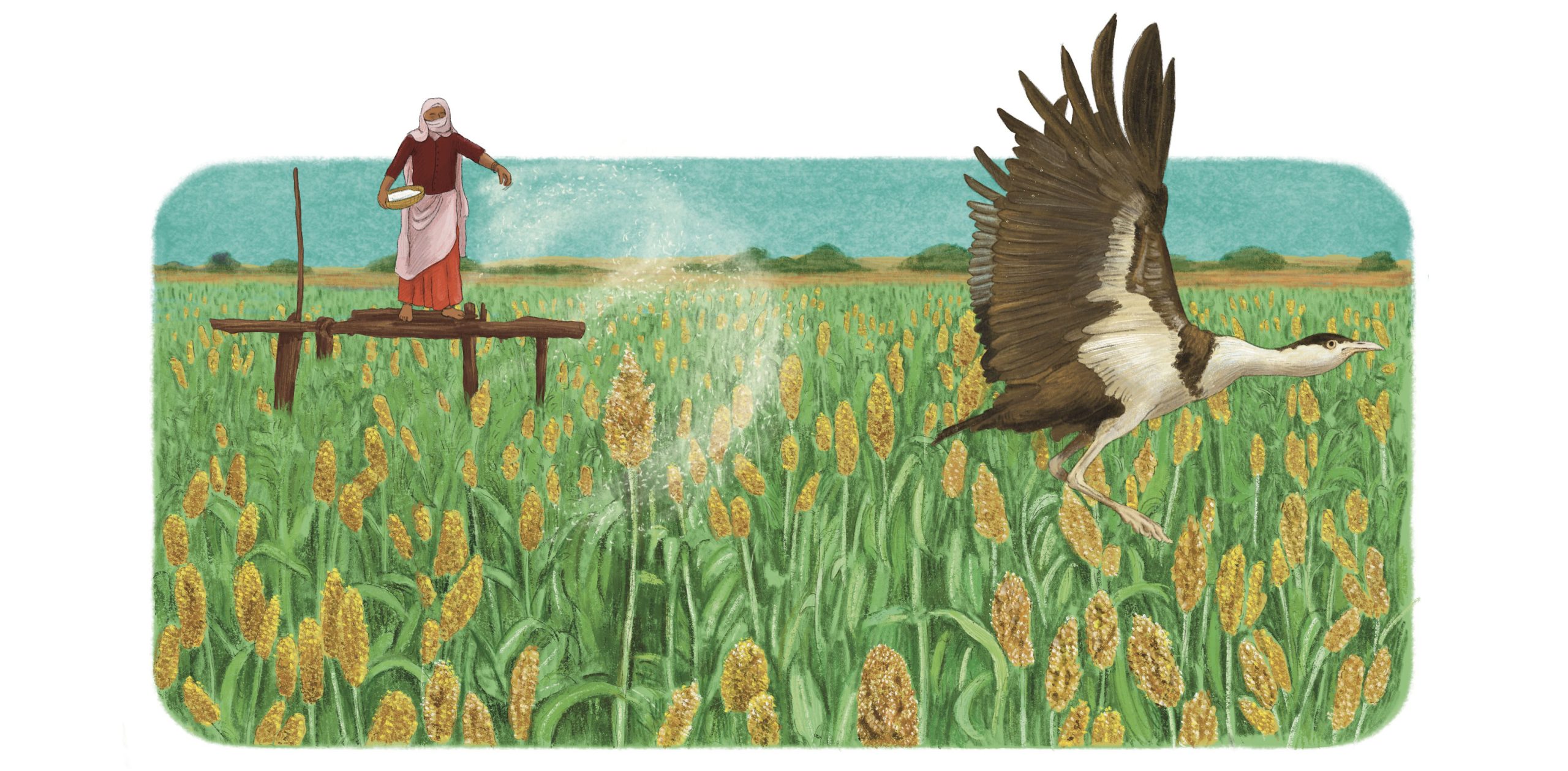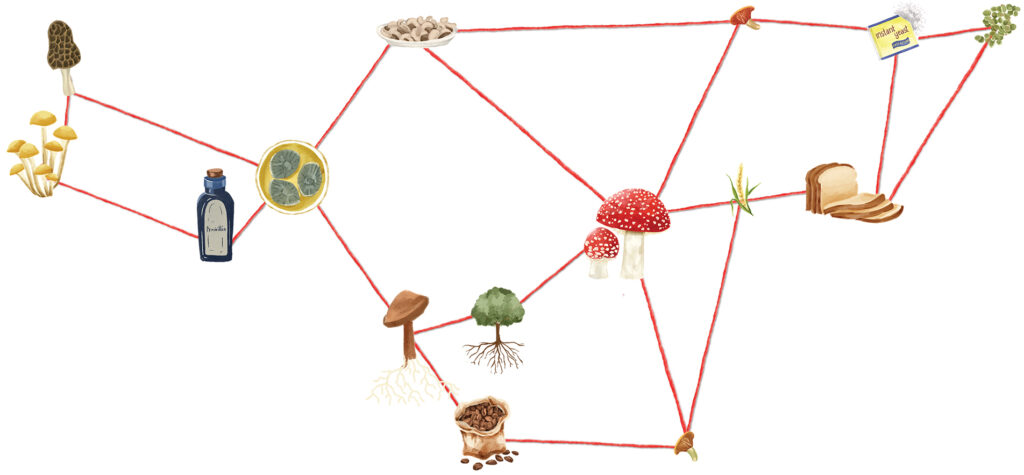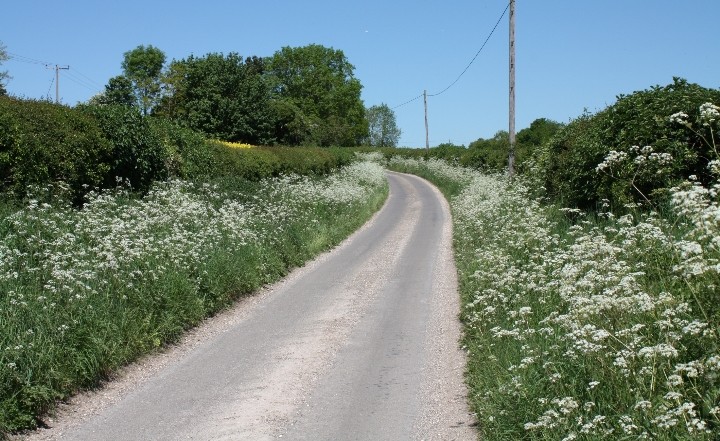As a conservation professional, I’m rarely emotional about the fate of any species and optimistically believe that someone, somewhere will save it from extinction. The plight of the great Indian bustard, however, is an exception and provokes a deep sense of frustration given that supposed government-mediated conservation could be a façade for insidiously permitting development within its habitat. The species continues to quietly slide away into obscurity. In this perspective, I attempt to demonstrate how prevailing government action has ignored and circumvented good science founded on conservation biology and landscape ecology principles to bring the species back from the brink.
The evidence that the Critically Endangered great Indian bustard is on the precipice is stark. Endemic to India, less than 150 individuals persist within what remains of our arid and semi-arid grasslands. Although previously widespread in India and Pakistan, perhaps more than 90 percent of the global population is now restricted to the Thar Desert. There are only a few other areas in the country where the species still survives. Presently, the Gujarat and Karnataka bustards are the only confirmed evidence of the species outside the Thar Desert and these populations are certainly not viable.
I note with concern recent reports that as compared to 2023 when six individuals were seen in the Siruguppa grasslands in the Ballari district in Karnataka, only two were seen recently. In the Naliya Grassland (an Important Bird and Biodiversity Area) in the Kutch district of Gujarat, which previously supported a healthy population of bustards, there now appear to be only four females and no males.
Turning good conservation planning around
In my opinion, the government’s recognition of the imminent threats faced by great Indian bustards indeed began safeguarding the species through robust scientific research and planning. Through funds from the Compensatory Afforestation Management and Planning Authority (CAMPA) in 2020, it financed a study—conducted by the Wildlife Institute of India (WII)—in 4,200 km2 of bustard habitat in and around the Desert National Park in Rajasthan. The study found that transmission lines killed 84,000 birds of multiple species annually. The great Indian bustard is particularly prone to collision due to its large size, limited frontal vision and heavy weight—and many died through collisions with transmission lines.
The WII study also included systematic field surveys of bustard presence and satellite telemetry of several individuals across the Thar Desert. From these surveys, three areas were earmarked for safeguarding the species based on intensity of habitat utilisation: priority (13,000 km2), potential (78,500 km2) and additional important areas (around 6600 km2).
In April 2021, the Supreme Court—recognising the threat that transmission lines and wind turbines posed to the great Indian bustard—ordered that overhead transmission lines in priority and potential bustard habitats in Rajasthan and Gujarat be underground. The Central government, however, maintained that it’s impossible to follow this order due to costs and other factors. The Supreme Court then decided to rescind the 2021 order resulting in a fresh judgement in April 2024 that overturned years of good research and planning.
An insightful opinion piece by Debadityo Sinha for NDTV on April 11, 2024 indicates how facetious this ruling was, especially the Central government’s arguments that other threats are more significant than the impact of transmission lines, that prevailing technical transmission issues exist with undergrounding transmission lines and, rather sweepingly, that climate change will impact all biodiversity in the Thar Desert. Sinha’s key point is that “while this judgement is rooted in complying with climate change agreements, it contradicts our commitment to conventions such as the Conventions on Biological Diversity and Migratory Species (India was instrumental in categorising the great Indian bustard as a migratory species)”.
I further question the scientific and moral wisdom behind the Ministry of Environment, Forests and Climate Change sanctioning INR 56 crores (US$ 67 million) in July 2024 from CAMPA funds to restore populations of the great Indian bustard through captive breeding, reintroduction to the wild, and habitat restoration. While these seem bold steps to save the species from extinction, they sidestep the real issues behind the likely path to extinction for the species, and appear to be a controversial “offset”, fraught with uncertainty in terms of success and falling short of holistically safeguarding the Thar Desert habitat of the species.
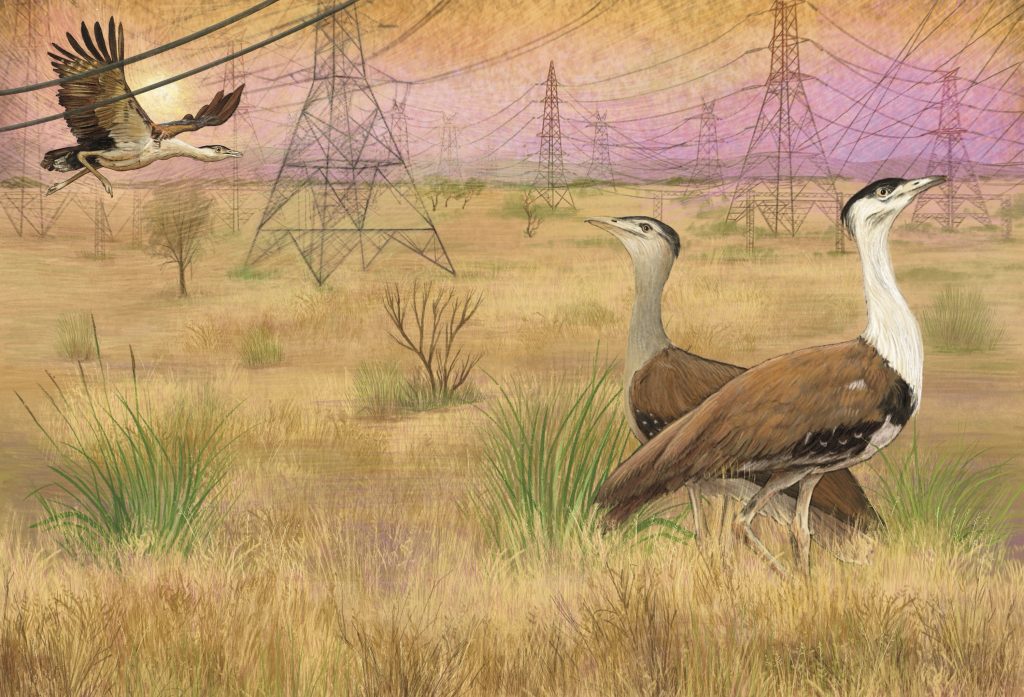
The need for landscape-scale planning
In my opinion, there is justification for demarcating a large potential area. Both the WII surveys and those carried out by the Bombay Natural History Society (BNHS) in 2020–21, found great Indian bustard aggregations in the Desert National Park and the Pokharan Firing Range in the priority area. But bustards also dispersed southwest of the Pokharan Firing Range outside the priority area. Furthermore, less than 20 years ago, individuals were recorded north and east of the firing range.
These data indicate that while the bustards are largely confined to two aggregations, excursions from the priority area occur. Additionally, I’m certain that climate change influencing water and food resources and future land use could cause dispersals to areas where the species has not been seen before.
Bustard home ranges typically average around 100 km2. But long-term telemetry data collected by WII indicate that the population today is far more fragmented than when the species was distributed across western Rajasthan. There could be several reasons for this.
For instance, intrusions such as transmission lines or wind turbines could restrict dispersal. During my visits to the bustard priority area, I was astounded by the high density of transmission lines criss-crossing a landscape with spectacular biodiversity. These structures serve as a grim reminder that for several soaring birds, aerial space is also habitat and needs to be considered in landscape planning. Moreover, the 2020 WII study indicated that where transmission line densities increased, the great Indian bustard went locally extinct.
The government conservation strategy for the great Indian bustard currently includes:
- Demarcation of grassland enclosures—thought to be breeding and foraging areas for the bustard by keeping them predator-free. The 2020 WII study reports that the feral dog populations in the Thar Desert landscape increased sixfold between 2015–17. Feral dogs predate on bustard nests and are believed to be a significant catalyst for their extinction.
- Removing invasive tree and shrub species, particularly Prosopis juliflora as this does not allow natural grass growth, which is preferred habitat for the species.
- Preventing incompatible land use, such as agriculture.
- Banning the use of malathion, a pesticide which was used intensively to control a locust infestation in 2019, and which was linked to bustard declines in the WII report. The pesticide is potentially harmful to birds and could affect bustards through contamination of water resources and foraging areas.
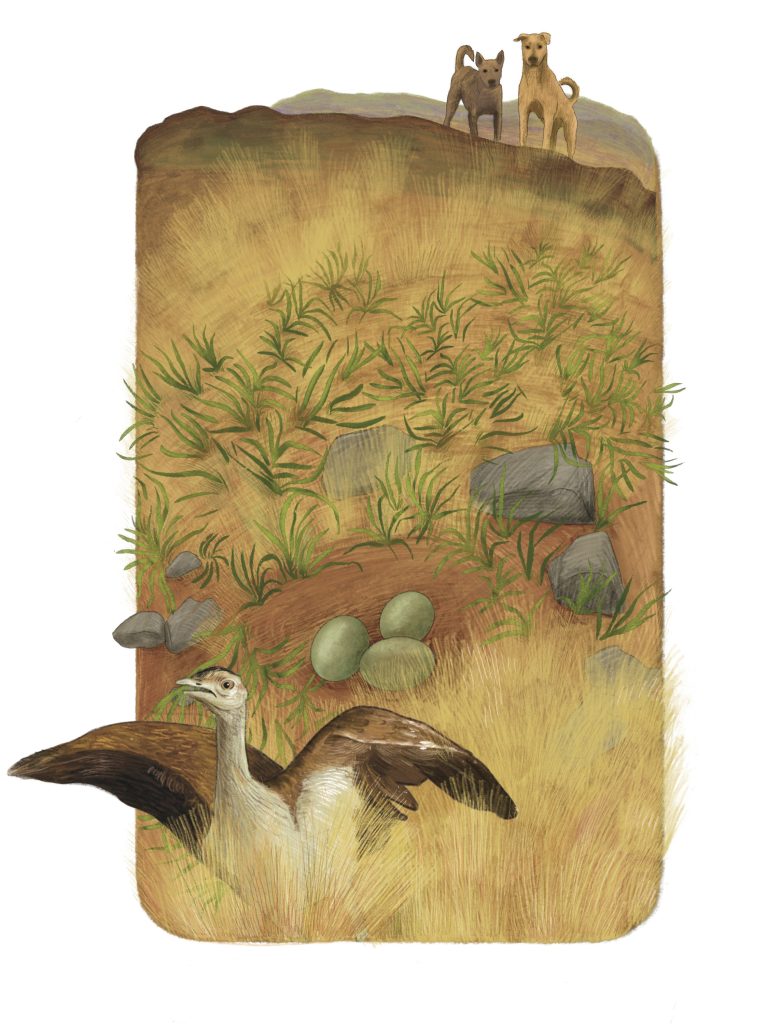
Mitigating these threats could make these enclosures important source sub-populations for bustard recovery in the Thar Desert. Several enclosures already exist in the Desert National Park, the Pokharan Firing Range and adjacent to the Degrai Oran—a sacred grove—outside the priority area. However, I fear that akin to the decline of the small bustard populations in Karnataka and Gujarat, the reality is that they cannot survive in these enclosures alone and need to disperse over longer distances for foraging and breeding.
The isolation of these sub-populations is more pronounced than perceived. The two great Indian bustard enclosures close to Rasla village are adjacent to the Degrai Oran—the grove revered by the local communities and utilised frequently by bustards. Colleagues who have carried out extensive surveys close to these enclosures have reported that the oran is surrounded by transmission lines and high mortality of bustards could be expected.
There have been three known fatalities of great Indian bustards between 2020–23, and perhaps others that were not recorded. Central Electrical Authority guide lines require power lines in bustard habitats be equipped with bird flight diverters—devices installed on transmission lines that prevent birds from colliding with them by enhancing the visibility of the lines. Several transmission lines in this region do not have diverters or, if present, have limited efficacy because they are old and faded and do not contrast with the background. The absolute disregard for any norms to save the species is shockingly evident here and this disregard persists elsewhere despite regulations.
Human-induced mortality of great Indian bustards in these small, isolated sub-populations is catastrophic. A paper published by Suthirta Dutta and colleagues from WII in 2010 predicts that populations of less than 25 individuals have a 67–100 percent probability of going extinct in 100 years, if human-induced mortality is not completely controlled.
These results are ominous today. First, fragmented sub-populations are smaller than in the past, and even without human-induced mortality, are prone to extinction. Second, mortality from collision with transmission lines and wind turbine blades may occur more frequently than observed. The 2020 WII study reported an estimated 18 bustards could die each year from collisions with transmission lines.
Scientific solutions exist but delays are perilous
Why are we delaying pertinent actions to save the species? Several organisations, including WII, BNHS, Corbett Foundation and incredibly diligent grassroots conservation organisations, have provided adequate data and well-founded solutions for the conservation of the great Indian bustard.
As to where the power transmission lines should go underground the answer is obvious—those surrounding enclosures are priorities. The 2020 report demarcated certain areas as “critical migration areas”, allowing for dispersal and genetic exchange between isolated sub-populations. Undergrounding power lines in these areas could significantly reduce mortality. Debadityo Sinha, in his opinion piece, argued that costs for undergrounding are only 3–5 percent of the earnings from power generation. Given the environmental costs, typically never considered in a cost-benefit analysis, these costs are not prohibitive!
In other great Indian bustard areas with records of bustard presence in the last five years, diverters should be mandatory. The efficacy of diverters in reducing collision risk is not yet scientifically established. However, there is some guidance available from a related species—the Great Bustard (Otis tarda), found in parts of Europe and northern Asia. While the species has also been heavily impacted through collisions with transmission lines, there is a natural tendency to avoid transmission lines which could be enhanced through diverters.
A call for immediate action
We cannot let the great Indian bustard go extinct on our watch. That would be a travesty of environmental as well as climate justice. Excellent studies indicate that 10 percent of carbon sequestration in California occurs because of the Mojave Desert, also threatened by renewable energy expansion. Opening the Thar Desert to rampant renewable energy development would destroy unique habitats for numerous threatened and migratory species, the ecosystem services it provides, and ultimately our faith in the government commitment to safeguarding our unique biodiversity. The Bishnoi community has protected the desert tirelessly and cannot be let down!
In December 2024, the Supreme Court directed the Rajasthan state government to identify and notify its sacred groves (such as orans). An earlier Centrally Empowered Commission recommendation asking the
state government to identify sacred groves and to declare sacred groves as “deemed forests”, barring highly fragmented ones, was delayed due to the state’s own interpretation of a “deemed forest”. This resulted in an affidavit objecting to the delay leading to the 2024 judgment further clarifying that the “deemed forest” classification should not depend on the size or extent of the groves, but instead focus solely on their purpose and cultural and ecological significance to the local community.
This judgement, despite the long delay potentially under mining conservation of threatened species like the great Indian bustard, could secure vital habitat in orans, especially when implemented with local communities. Safeguarding orans through legal action could also influence the location of transmission lines and wind turbines and prevent catastrophic fragmentation of the sacred groves, enhancing dispersal of bustards.
The balance between honouring India’s climate change commitments and preventing the great Indian bustard from going extinct is entirely feasible and requires:
- Scrupulously protecting the source sub-populations from the threats described above
- Ensuring that all existing and future transmissionlines are undergrounded in and around enclosures. The zone of undergrounding around the enclosure can be guided by the bustard habitat utilisation data from WII telemetry studies.
- That existing and future transmission lines in the
critical migration area are undergrounded - That bird flight diverters are made mandatory at other locations in the priority and potential areas where bustard presence has been reliably recorded in the last five years
- That the Supreme Court empowers the committee to monitor the above actions and penalise defaulters
These actions should be ably guided by scores of scientists, conservationists, communities and government agencies. Let’s hope that the Supreme Court acts urgently and wisely to secure a national heritage.

Note: This article was inspired by the author’s deep concern for the fate of the great Indian bustard, especially given that pragmatic but unheeded solutions exist to prevent the species’ extinction. He has worked extensively across the bustard landscapes in Rajasthan and Gujarat. The opinions expressed in the article are his personal views and do not represent those of any organisations he works with.
Further Reading
Dutta, S., T. Karkaria, C. M. Bipin, Uddin, V. Kher, H. Sharma, H. Joshi et al. 2022. Bustard Recovery Program: Progress Report. Wildlife Institute of India, Dehradun.
Dutta S, A. R. Rahmani and Y. V. Jhala. 2011. Running out of time? The great Indian bustard Ardeotis nigriceps—status, viability, and conservation strategies. European Journal of Wildlife Research 57: 615–625.
Jhala, Y.V., S. Dutta, G. S. Bhardwaj, T. Karkaria, C. M. Bipin et al. 2020. Conserving great Indian bustard Landscapes through Scientific Understanding and Participatory Planning. Final Technical Report Submitted to Rajasthan State Pollution Control Board. Wildlife Institute of India, Dehradun 248001, India.TR/2020/21/.
